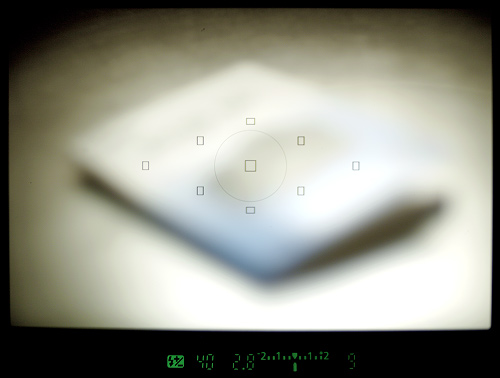Canon EOS 5DIntroduction
After two years and two months of using Canon EOS 20D I decided to go full frame. I kind of have been waiting full frame camera with sensor with dust cleaning system, but since it seems Canon isn't updating (on spring 2007 Canon released Canon EOS 1D mk III but no replacement to 5D neither Canon 1Ds Mk II). Canon may hold the updating since it has market covered - no-one else won't deliver full frame cameras (2007/July). Ergonomics
After 20D the moving to 5D was not a big deal. All the functions were more or less the same. Camera feels very good on hand. Viewfinder & Manual Focusing
Viewfinder screen Ee-AThis is the standard viewfinder screen which comes with the camera. The viewfinder is very bright and if you don't have to manual focus I think it's excellent. However the standard viewfinder screen is a joke for manual focusing. Luckily Canon made the focusing screen changeable by user like in 1D series and manual focusing problems can be avoided easily by changing lens. Viewfinder screen Ee-S
Canon is making also making special focus screen for manual focusing lenses which aperture is faster than f/2.8. It has "steeper parabola" and should make image to pop into focus. However I didn't find it so great. Of course it's better than the original focusing screen, but I didn't found the image to "pop" into focus. Actually I had to check my old Pentax ME and Pentax 50/1.7 and to my supprice I found that 1) Pentax viewfinder image is bigger 2) Pentax viewfinder image is brigter 3) Pentax is easier to manual focus (if image is in focus or out of focus it appear better from Pentax viewfinder). I later may consider alternative option for focusing screen (e.g. Brightscreen), but at the moment have to survive what I have. Also before going to alternative screens I will try the Bill Maxwell Hi-Lux threatment (unofficial homepage: link). Image Quality: ISO performanceIn addition to lower noise on higher ISOs 5D also offers more exact way of setting the ISO speeds. They can be set 1/3 stop steps, when in 20D they had to be set by 1 stop steps. Image Quality: Colors & ContrastFor reason or another I have found out that 5D photos seem to require less digital darkroom work than images from 20D. I don't know is this due to less strong antialias filter or what, but this happens with same lenses. For some part this is definitely caused because with full frame sensor the image doesn't have to be magnified as much as with 1.6x crop. Image Quality: Lens performanceBigger sensor has positive and negative effects. Positive effect is of course that the image doesn't have to be enlarged so much and even lesser quality lenses appear better due to that. Negative effects are caused because camera is no longer using just the "sweet spot" of the lens in middle, instead sensor also get picture from the outer zones of image circle lens is projecting. Typically this is more problem with wider lenses. Long tele lenses have so big image circle that there usually are problems. Less enlargement requiredTo get same size print less enlargement is required than from cropped camera. In practice this that lens doesn't have to deliver as many lines/mm as it does in cropped camera to get same end result. Corner performance
Vignetting
At full aperture most of the lens have some vignetting. This usually goes away when you close the aperture couple stops. With the zoom lenses and lower quality primes this is bigger problem. DistortionI found out my Canon EF 17-40 f/4 L USM to have much worse distortion at full frame than it does have on 1.6x crop Dust?Add chapter here when sensor needs to be cleaned first time. ConclusionPros
Cons
|
